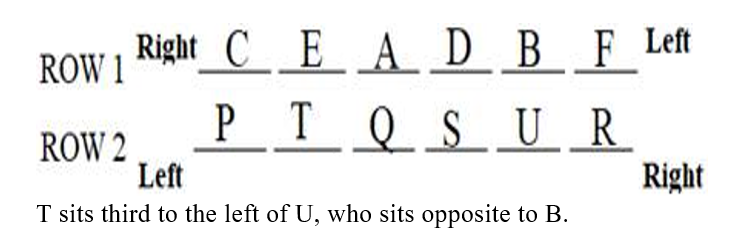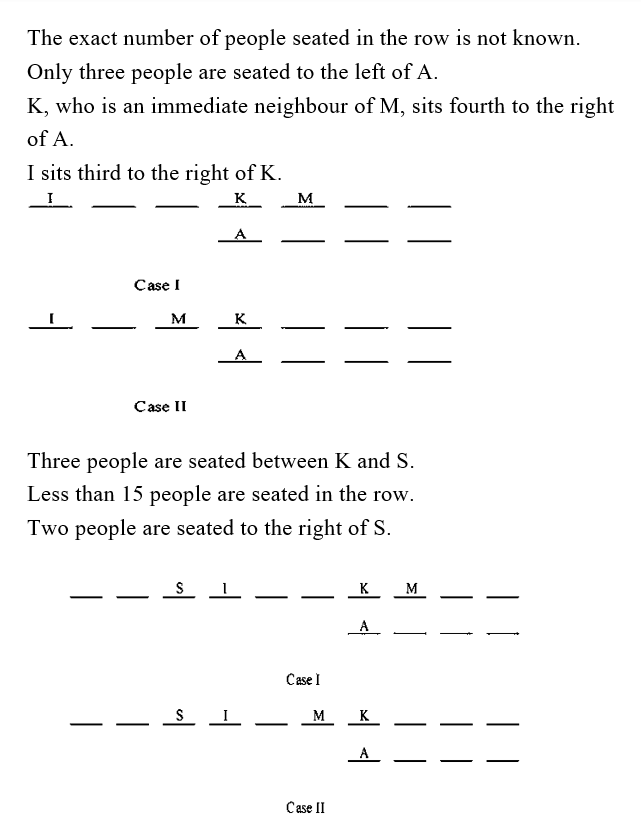Question 1:
In the question given below, a statement is followed by conclusions given in options based on the statement. Study the conclusions and select the correct option as the answer.
नीचे दिए गए प्रश्न में, एक कथन का अनुसरण करते हुए कथन के आधार पर विकल्पों में निष्कर्ष दिए गए हैं। निष्कर्षों का अध्ययन करें और उत्तर के रूप में सही विकल्प का चयन करें।
Statement: / कथन:
Y ≤ U = R; L > K ≥ X ≤ Y
Question 2:
Directions: Twelve persons are sitting in two parallel linear rows. A, B, C, D, E and F sit in row 1 facing the south direction and P, Q, R, S, T and U sit in row 2 facing the north direction.
D sits second to the left of the person who sits opposite to T. S sits immediate right of Q, who sits opposite to A. Neither E nor U sits at the end of the row. Three persons sit between R and T. P does not sit opposite to F. B sits third to the left of E.
निर्देश: बारह व्यक्ति दो समानांतर रैखिक पंक्तियों में बैठे हैं। पंक्ति 1 में A, B, C, D, E और F दक्षिण दिशा की ओर मुखरित होकर बैठे हैं और पंक्ति 2 में P, Q, R, S, T और U उत्तर दिशा की ओर मुखरित होकर बैठे हैं।
D, T के विपरीत बैठे व्यक्ति के बाएं से दूसरे स्थान पर बैठा है। S, Q के निकटस्थ दायें बैठा है और Q, A के विपरीत बैठा है। न तो E और न ही U पंक्ति के अंत में बैठा है। R और T के बीच में तीन व्यक्ति बैठे हैं। P, F के विपरीत नहीं बैठा है। B, E के बायें से तीसरे स्थान पर बैठा है।
Who sits opposite to R?
R के विपरीत कौन बैठा है?
Question 3:
Directions: Twelve persons are sitting in two parallel linear rows. A, B, C, D, E and F sit in row 1 facing the south direction and P, Q, R, S, T and U sit in row 2 facing the north direction.
D sits second to the left of the person who sits opposite to T. S sits immediate right of Q, who sits opposite to A. Neither E nor U sits at the end of the row. Three persons sit between R and T. P does not sit opposite to F. B sits third to the left of E.
निर्देश: बारह व्यक्ति दो समानांतर रैखिक पंक्तियों में बैठे हैं। पंक्ति 1 में A, B, C, D, E और F दक्षिण दिशा की ओर मुखरित होकर बैठे हैं और पंक्ति 2 में P, Q, R, S, T और U उत्तर दिशा की ओर मुखरित होकर बैठे हैं।
D, T के विपरीत बैठे व्यक्ति के बाएं से दूसरे स्थान पर बैठा है। S, Q के निकटस्थ दायें बैठा है और Q, A के विपरीत बैठा है। न तो E और न ही U पंक्ति के अंत में बैठा है। R और T के बीच में तीन व्यक्ति बैठे हैं। P, F के विपरीत नहीं बैठा है। B, E के बायें से तीसरे स्थान पर बैठा है।
Four of the following are related to each other in some way and thus form a group, who among the following does not belong to that group?
निम्नलिखित में से चार किसी न किसी रूप में एक दूसरे से संबंधित हैं और इस प्रकार एक समूह बनाते हैं, निम्नलिखित में से कौन उस समूह से संबंधित नहीं है?
Question 4:
Directions: Twelve persons are sitting in two parallel linear rows. A, B, C, D, E and F sit in row 1 facing the south direction and P, Q, R, S, T and U sit in row 2 facing the north direction.
D sits second to the left of the person who sits opposite to T. S sits immediate right of Q, who sits opposite to A. Neither E nor U sits at the end of the row. Three persons sit between R and T. P does not sit opposite to F. B sits third to the left of E.
निर्देश: बारह व्यक्ति दो समानांतर रैखिक पंक्तियों में बैठे हैं। पंक्ति 1 में A, B, C, D, E और F दक्षिण दिशा की ओर मुखरित होकर बैठे हैं और पंक्ति 2 में P, Q, R, S, T और U उत्तर दिशा की ओर मुखरित होकर बैठे हैं।
D, T के विपरीत बैठे व्यक्ति के बाएं से दूसरे स्थान पर बैठा है। S, Q के निकटस्थ दायें बैठा है और Q, A के विपरीत बैठा है। न तो E और न ही U पंक्ति के अंत में बैठा है। R और T के बीच में तीन व्यक्ति बैठे हैं। P, F के विपरीत नहीं बैठा है। B, E के बायें से तीसरे स्थान पर बैठा है।
What is the position of A with respect to C?
C के सन्दर्भ में A का स्थान क्या है?
Question 5:
Directions: Twelve persons are sitting in two parallel linear rows. A, B, C, D, E and F sit in row 1 facing the south direction and P, Q, R, S, T and U sit in row 2 facing the north direction.
D sits second to the left of the person who sits opposite to T. S sits immediate right of Q, who sits opposite to A. Neither E nor U sits at the end of the row. Three persons sit between R and T. P does not sit opposite to F. B sits third to the left of E.
निर्देश: बारह व्यक्ति दो समानांतर रैखिक पंक्तियों में बैठे हैं। पंक्ति 1 में A, B, C, D, E और F दक्षिण दिशा की ओर मुखरित होकर बैठे हैं और पंक्ति 2 में P, Q, R, S, T और U उत्तर दिशा की ओर मुखरित होकर बैठे हैं।
D, T के विपरीत बैठे व्यक्ति के बाएं से दूसरे स्थान पर बैठा है। S, Q के निकटस्थ दायें बैठा है और Q, A के विपरीत बैठा है। न तो E और न ही U पंक्ति के अंत में बैठा है। R और T के बीच में तीन व्यक्ति बैठे हैं। P, F के विपरीत नहीं बैठा है। B, E के बायें से तीसरे स्थान पर बैठा है।
How many persons sit to the left of P?
P के बायें कितने व्यक्ति बैठे हैं?
Question 6:
Directions: Twelve persons are sitting in two parallel linear rows. A, B, C, D, E and F sit in row 1 facing the south direction and P, Q, R, S, T and U sit in row 2 facing the north direction.
D sits second to the left of the person who sits opposite to T. S sits immediate right of Q, who sits opposite to A. Neither E nor U sits at the end of the row. Three persons sit between R and T. P does not sit opposite to F. B sits third to the left of E.
निर्देश: बारह व्यक्ति दो समानांतर रैखिक पंक्तियों में बैठे हैं। पंक्ति 1 में A, B, C, D, E और F दक्षिण दिशा की ओर मुखरित होकर बैठे हैं और पंक्ति 2 में P, Q, R, S, T और U उत्तर दिशा की ओर मुखरित होकर बैठे हैं।
D, T के विपरीत बैठे व्यक्ति के बाएं से दूसरे स्थान पर बैठा है। S, Q के निकटस्थ दायें बैठा है और Q, A के विपरीत बैठा है। न तो E और न ही U पंक्ति के अंत में बैठा है। R और T के बीच में तीन व्यक्ति बैठे हैं। P, F के विपरीत नहीं बैठा है। B, E के बायें से तीसरे स्थान पर बैठा है।
T sits third to the left of ___, who sits opposite to ____.
T, _____ के बायें से तीसरे स्थान पर बैठा है, जो _____ के विपरीत बैठा है।
Question 7:
Two statements numbered I and II are given below. You have to decide whether the data provided in the statements are sufficient to answer the question.
In the group of five friends, A, B, C, D and E.It is given that B is not the tallest member in the group. Who is the tallest in the group?
नीचे दो कथन क्रमांकित I और II दिए गए हैं। आपको यह निर्धारित करना है कि कथनों में दी गई सूचना प्रश्न का उत्तर देने के लिए पर्याप्त है या नहीं।
यह दिया गया है कि पाँच दोस्तों A, B, C, D और E के समूह में B कद में सबसे लंबा सदस्य नहीं है। समूह में कद में सबसे लंबा व्यक्ति कौन है?
Statement I: B is taller than D only. A is shorter than only E.
कथन I: B केवल D से कद में लंबा है। A केवल E से कद में नाटा है।
Statement II: C is taller than D. E is taller than both A and C and A is taller than C.
कथन II: C, D से कद में लंबा है। E, A और C दोनों से कद में लंबा है और A, C से कद में लंबा है।
Question 8: 
Question 9:
The question given below consists of two statements numbered I and II given below it. You have to decide whether the data given in the statements are sufficient to answer the question.
Eight people lived in eight different floors of a building numbered from 1-8 where 8 is the topmost floor. U lived immediately above S on an even floor. Three people lived between R and W where W lived below R. Q lived on an even floor. P did not live on 5th floor.
नीचे दिए गए प्रत्येक प्रश्न में एक प्रश्न और उसके नीचे दो कथन I और II दिए गए हैं।
किसी इमारत, जिसका क्रमांक 1-8 है, की आठ विभिन्न मंज़िलों में आठ व्यक्ति रहते थे, जहाँ 8 सबसे ऊपरी मंज़िल है। U, S के ठीक ऊपर सम अंकीय मंज़िल पर रहता था। R और W के मध्य में तीन व्यक्ति रहते थे, जहाँ W, R से नीचे रहता था। Q सम अंकीय मंज़िल पर रहता था। P, 5वीं मंज़िल पर नहीं रहता था।
How many people lived between R and V?
R और V के मध्य में कितने व्यक्ति रहते थे?
Statement / कथनः
I. One person lived between V and P. T lived on 7th floor. / V और P के मध्य में एक व्यक्ति रहता था। T, 7वीं मंज़िल पर रहता था।
Statement / कथनः
II. U lived adjacent to T. Three people lived between V and T. V lived above P. / U, T के आसन्न रहता था। V और T के मध्य में तीन व्यक्ति रहते थे। V, P से ऊपर रहता था।
Read both the statements and mark your answer as:
दोनों कथनों को पढ़िए और अपने उत्तर को इस रूप में चिह्नित कीजिए :
Question 10:
Few people are standing in a row, facing towards the South. Only a few positions are known to us.
Only three people are seated to the left of A. K, who is an immediate neighbour of M, sits fourth to the right of A. Three people are seated between K and S. Two people are seated to the right of S. I sits third to the right of K. Less than 15 people are seated in the row. कुछ व्यक्ति एक पंक्ति में दक्षिण की ओर मुखरित होकर बैठे हैं। केवल कुछ के स्थान हमें ज्ञात हैं।
A के बायीं ओर केवल तीन व्यक्ति बैठे हैं। K, M का निकटस्थ पड़ोसी है और K, A के दायें से चौथे स्थान पर बैठा है। K और S के बीच में तीन व्यक्ति बैठे हैं। S के दायीं ओर दो व्यक्ति बैठे हैं। I, K के दायें से तीसरे स्थान पर बैठा है। पंक्ति में 15 से कम व्यक्ति बैठे हैं।
How many people are seated in the row?
पंक्ति में कितने व्यक्ति बैठे हैं?






